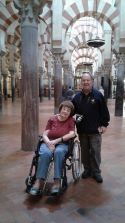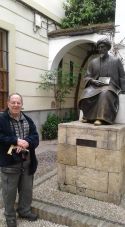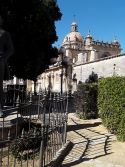
 Reconquista. We also visited a small town nearby, (note the burro taxi) where our guide got us into a museum featuring Picasso ceramics. Picasso was born here.
Reconquista. We also visited a small town nearby, (note the burro taxi) where our guide got us into a museum featuring Picasso ceramics. Picasso was born here.Exploring International Business with Illinois Wesleyan's Fred Hoyt

 Reconquista. We also visited a small town nearby, (note the burro taxi) where our guide got us into a museum featuring Picasso ceramics. Picasso was born here.
Reconquista. We also visited a small town nearby, (note the burro taxi) where our guide got us into a museum featuring Picasso ceramics. Picasso was born here.
Cordoba.. the great mosque with the cathedral inside, Roman bridge, and birthplace of Maimonides. We were in the mosque turned cathedral when word came that it was closing tomorrow for 2  weeks (as we thought
weeks (as we thought  optimistically at the time). In fact, COVID was causing Spain itself to shut down.
optimistically at the time). In fact, COVID was causing Spain itself to shut down.
Our trip to Granada was canceled and we sped to Malaga, where we were supposed to catch our flight home. We were now in the hands of our travel agent. Carolyn’s dream of Gibraltar and mine of Granada were thwarted as we  scrambled to get back to the US. Get us home, I pleaded, and left the details to our agent. Who knew it would be the end of our international travel?
scrambled to get back to the US. Get us home, I pleaded, and left the details to our agent. Who knew it would be the end of our international travel?
Seville
March 12, 2020
“Real” in Spanish means “royal”, and the “Real” Alcazar we saw today is real in both senses—regal (it’s the oldest continuously used palace in Europe) and the top of the line. Our guide pointed to it as one of the contributors to her story of Seville as a blend of the three world religions. I beg to correct her characterization, at least to a small degree.
One of those religions is reflected in the name of our hotel—Casas de la  Juderia—the house of the Jews. True, it’s in the old Jewish Quarter, but there’ve been no resident Jews here since their expulsion from Castile in 1481 and Spain in 1492. There were none here during Muslim times either (the 500 years from 711 until the conquest in the 1248). The synagogue next door was demolished, and on its site sits the baroque church of Santa Maria la Blanca, complete with a painting by the 16th century local, Murillo, who refused to move to Madrid, and thus is still a local favorite. True, from 1248 the city housed the second largest Jewish population in Spain, and there’s at least one street named for a Levi, who was treasurer to the King of Castile. But the Sephardic museum that might have shed light on contributions that have lasted is undergoing renovations.
Juderia—the house of the Jews. True, it’s in the old Jewish Quarter, but there’ve been no resident Jews here since their expulsion from Castile in 1481 and Spain in 1492. There were none here during Muslim times either (the 500 years from 711 until the conquest in the 1248). The synagogue next door was demolished, and on its site sits the baroque church of Santa Maria la Blanca, complete with a painting by the 16th century local, Murillo, who refused to move to Madrid, and thus is still a local favorite. True, from 1248 the city housed the second largest Jewish population in Spain, and there’s at least one street named for a Levi, who was treasurer to the King of Castile. But the Sephardic museum that might have shed light on contributions that have lasted is undergoing renovations.

 The “real Alcazar” does make a case for the blending of the Muslim and Catholic traditions, however. The original Alcazar is now mostly destroyed, having given way to a royal Christian palace on the same grounds, enlarged and embellished by successive Bourbon and Habsburg rulers. Today’s King stays here when he’s in town—in non-public quarters.
The “real Alcazar” does make a case for the blending of the Muslim and Catholic traditions, however. The original Alcazar is now mostly destroyed, having given way to a royal Christian palace on the same grounds, enlarged and embellished by successive Bourbon and Habsburg rulers. Today’s King stays here when he’s in town—in non-public quarters.
 The public areas have a lot of artwork that reflects the Muslim influence; our guide said that Christian Pablo I, responsible for the rebuild in 1364, borrowed Muslim artists from Granada for the tiles that make the palace colorful. There’s even a word for Spanish architecture influenced by Islam—“Mudejar.” A later addition, however, added an altar and a Gothic wing; the gardens alone are 19 acres. And speaking of Gothic, the Cathedral, across
The public areas have a lot of artwork that reflects the Muslim influence; our guide said that Christian Pablo I, responsible for the rebuild in 1364, borrowed Muslim artists from Granada for the tiles that make the palace colorful. There’s even a word for Spanish architecture influenced by Islam—“Mudejar.” A later addition, however, added an altar and a Gothic wing; the gardens alone are 19 acres. And speaking of Gothic, the Cathedral, across  from the
from the palace, is now the largest Gothic church in the world, and the third in size behind the Vatican and St. Paul’s in London. It is rectangular, having been built in the 1400s (started 1401, completed a century later) on the site of a mosque. The bell tower was once the minaret for the mosque, and its size indicates the mosque may well have
palace, is now the largest Gothic church in the world, and the third in size behind the Vatican and St. Paul’s in London. It is rectangular, having been built in the 1400s (started 1401, completed a century later) on the site of a mosque. The bell tower was once the minaret for the mosque, and its size indicates the mosque may well have  been one of the largest in the world as well.
been one of the largest in the world as well.
The Cathedral houses two artifacts that attest to the commercial importance of Seville. Before the local river silted, it was the main seaport facing the Atlantic, 60 miles upriver from the ocean. It was from here that the Admiral of the Ocean (Columbus) set sail for the New World, and it was to this Cathedral that eventually his bones returned (at least some of them, having rested in the Dominican Republic and Cuba at one time). It was from Seville that Magellan set sail around the world, too; of his 250 men, only 18 returned, under Captain Elcano. Magellan himself was eaten in the Philippines, I believe, so he’s only mentioned in the plaque indicating the voyage.
Two commercial sites we visited attest to the once-glory of Seville  commercially. The Tower of Gold was one of the Muslim wall towers. It guarded the river and had a chain that blocked passage of enemies’ ships and charged (probably gold) for passage by friends, at least until Fernando III sailed in and broke through the chain, capturing the city. The Tower is still there.
commercially. The Tower of Gold was one of the Muslim wall towers. It guarded the river and had a chain that blocked passage of enemies’ ships and charged (probably gold) for passage by friends, at least until Fernando III sailed in and broke through the chain, capturing the city. The Tower is still there.
 The other commercial site was the remains of an Iberia-American fair in 1929, ten years in the planning, that brought commercial exhibits and buildings from the former Spanish (and Portuguese) colonies in the New World. Many of them are still used by the countries that built them (the US consulate is in the US building, for example), but many of them are now government buildings or university buildings. The broad boulevards and parks remain as well. A similar fair in 1992, commemorating 500 years of Columbus’ expeditions, however, was more evanescent. The empty site allowed the local government to authorize a skyscraper because it was outside the central business district, where no building could be higher than the bell tower of the Cathedral.
The other commercial site was the remains of an Iberia-American fair in 1929, ten years in the planning, that brought commercial exhibits and buildings from the former Spanish (and Portuguese) colonies in the New World. Many of them are still used by the countries that built them (the US consulate is in the US building, for example), but many of them are now government buildings or university buildings. The broad boulevards and parks remain as well. A similar fair in 1992, commemorating 500 years of Columbus’ expeditions, however, was more evanescent. The empty site allowed the local government to authorize a skyscraper because it was outside the central business district, where no building could be higher than the bell tower of the Cathedral.
With a little more time, the one stop I would like to have made was at the Archeology Museum. While our guide wanted to reduce Seville to the three religions, there were at least two more periods I’d have liked to know more about. This was a Roman city for 500 years (or there was one nearby), and two emperors—Trajan and Hadrian—were born here, and the Visigoths swept in too, and our guide noted that the locals welcomed the Muslims in 711 in preference to the Christians. That might have made an interesting visit.
However, when we emerged, our guide told us that the Alhambra was closed tomorrow, that all museums were closed. I knew it was time to go home. We were lucky to have had an agent, who got us home before the curtain fell on travel in Europe.
March 11, 2020
Jerez enroute to Seville
22 hours of flights and airports, three movies, and over 4500 miles in the air, and we’re finally in Andalusia. Checking with my gps, however, discloses that we’re at the 37 th parallel, 3737 miles from home. And really out of touch with much news from the United States. I hadn’t realized that EU privacy laws, which changed last May, disabled most American news sources. I can get headlines, but when I click my usual sources–Trib/NYT/Wall Street Journal, and Pantagraph–I get a notice that they are banned from delivering content. And ESPN switches to the Spanish/European edition.

 Perhaps it’s just as well that we are enjoying where we are, which seems far indeed. We left Jerez earlier today for Seville, having seen the three biggest sites in Jerez, a city of 200,000 that has its roots in Phoenician, Roman, Muslim, Spanish cultures and histories. The Phoenicians left nothing except stories about Hannibal and Carthage, and vineyards. The legacy was one of the main crops of al-Andalusia (named for the Muslim influence, which lasted from 711 until the 13 th century, when Alfonso the Wise, so-named because he knew at least three languages, which made him wise at the time, reconquered this part of Spain from the Muslims). The soil apparently is excellent for a white grape that lends itself to sherry, and on the hill that
Perhaps it’s just as well that we are enjoying where we are, which seems far indeed. We left Jerez earlier today for Seville, having seen the three biggest sites in Jerez, a city of 200,000 that has its roots in Phoenician, Roman, Muslim, Spanish cultures and histories. The Phoenicians left nothing except stories about Hannibal and Carthage, and vineyards. The legacy was one of the main crops of al-Andalusia (named for the Muslim influence, which lasted from 711 until the 13 th century, when Alfonso the Wise, so-named because he knew at least three languages, which made him wise at the time, reconquered this part of Spain from the Muslims). The soil apparently is excellent for a white grape that lends itself to sherry, and on the hill that 
 commands the city, one of the wine bodegas is Gonzalez Byass, makers of Tio Pepe, the largest selling brand, and the most visited vineyard in Spain.
commands the city, one of the wine bodegas is Gonzalez Byass, makers of Tio Pepe, the largest selling brand, and the most visited vineyard in Spain.
I did my part, touring the facility, which included sampling four varieties. Mr. Gonzalez was a banker turned wine-grower (at 23) who took on Mr. Byass, an English financier, as a partner, and the two families, now in the sixth generation,  still run the company. It owns and sells a variety of wines around the globe, including Chilean, and some brandies. I was a little surprised to learn that sherries do not get packaged by year because it is a blended mixture, and can age up to 20 years—the older, the sweeter—like people, n’est ce pas?
still run the company. It owns and sells a variety of wines around the globe, including Chilean, and some brandies. I was a little surprised to learn that sherries do not get packaged by year because it is a blended mixture, and can age up to 20 years—the older, the sweeter—like people, n’est ce pas?
The second edifice on the hill that overlooks the city was the symbol of political power—the Alcazar. Apparently two Muslim dynasties ruled the  city, and each was responsible for establishing part of the Alcazar (if it starts with an al—it’s probably Islamic). The Alcazar was residence/fortress of th
city, and each was responsible for establishing part of the Alcazar (if it starts with an al—it’s probably Islamic). The Alcazar was residence/fortress of th e rulers. Much of it is restored—the horseshoe archway, the three room baths—hot, cold, and ablution—with star-like holes in the dome to remind the Muslims of their desert heritage, a small mosque (that became a chapel), and square ramparts and towers that proved the best views of the town. There’s also a garden and some pools, along with orange trees whose fragrance fills the air. The Alcazar became the residence of the mayor, one of whom built an 18th century baroque palace within it that somehow works with the Muslim architecture.
e rulers. Much of it is restored—the horseshoe archway, the three room baths—hot, cold, and ablution—with star-like holes in the dome to remind the Muslims of their desert heritage, a small mosque (that became a chapel), and square ramparts and towers that proved the best views of the town. There’s also a garden and some pools, along with orange trees whose fragrance fills the air. The Alcazar became the residence of the mayor, one of whom built an 18th century baroque palace within it that somehow works with the Muslim architecture.
Across from the Alcazar, and built on the site of the Mosque (winners can do that) is the basilica, a huge cathedral in its second version. The tower from the first remained after (I think) an 
 earthquake, and the rebuild was mostly gothic/baroque, two of my favorite church styles. Some of the altars and paintings came from convents and monasteries that were at one point or another confiscated. The main painting is a Zurbaran of a young Mary (late 16th century). When Pope John Paul II visited here in 1980, he elevated the cathedral to a basilica, meaning it’s the seat of the bishop.
earthquake, and the rebuild was mostly gothic/baroque, two of my favorite church styles. Some of the altars and paintings came from convents and monasteries that were at one point or another confiscated. The main painting is a Zurbaran of a young Mary (late 16th century). When Pope John Paul II visited here in 1980, he elevated the cathedral to a basilica, meaning it’s the seat of the bishop.
The three main sites were within easy walking distance from our hotel—enshrining religion, political power, and money at the time. We’re now in Seville, about 90 miles away, with another interesting story to tell, beginning with the name of our hotel, which is how I’ll start tomorrow night’s blog.